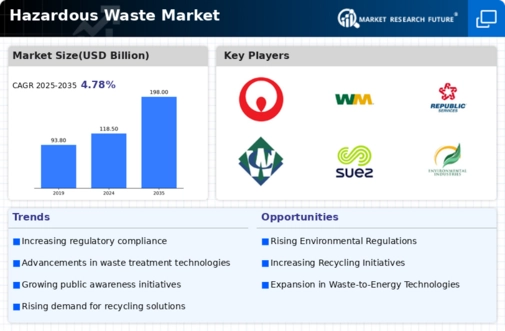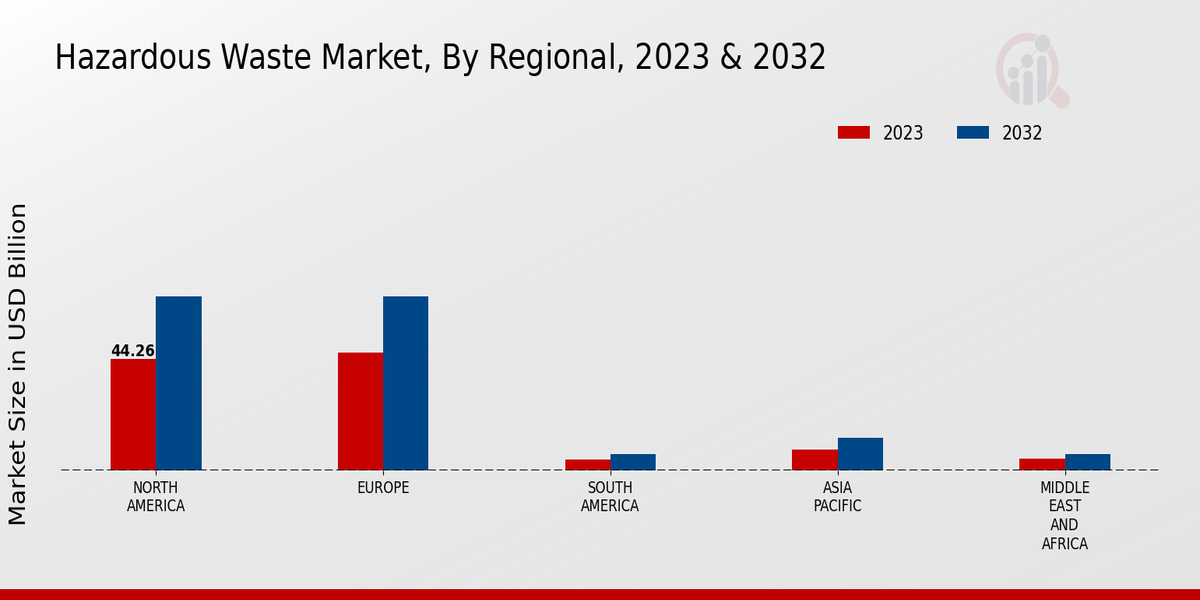Market Growth Projections
The Global Hazardous Waste Market Industry is poised for substantial growth, with projections indicating a market size of 118.5 USD Billion in 2024 and an anticipated increase to 198.0 USD Billion by 2035. This growth trajectory suggests a compound annual growth rate (CAGR) of 4.78% from 2025 to 2035, reflecting the increasing demand for hazardous waste management solutions across various sectors. The market's expansion is likely driven by factors such as regulatory compliance, technological advancements, and rising public awareness regarding environmental sustainability.
Economic Growth and Waste Generation
Economic growth is closely linked to the dynamics of the Global Hazardous Waste Market Industry. As economies expand, the production of goods increases, leading to higher volumes of hazardous waste. Industries such as pharmaceuticals, chemicals, and electronics are particularly notable contributors to hazardous waste generation. This correlation suggests that as global economies recover and grow, the demand for effective hazardous waste management solutions will rise correspondingly. The market's trajectory, with a projected increase to 198.0 USD Billion by 2035, reflects the economic activities that drive hazardous waste generation and the subsequent need for management services.
Regulatory Compliance and Enforcement
The Global Hazardous Waste Market Industry is significantly influenced by stringent regulatory frameworks aimed at managing hazardous waste. Governments worldwide are implementing and enforcing regulations that mandate proper disposal and treatment of hazardous materials. For instance, the Resource Conservation and Recovery Act in the United States establishes guidelines for hazardous waste management. Compliance with these regulations is not only a legal obligation but also a corporate responsibility, driving companies to invest in waste management solutions. As a result, the market is projected to reach 118.5 USD Billion in 2024, indicating a robust demand for compliance-driven services and technologies.
Growing Industrialization and Urbanization
The ongoing trends of industrialization and urbanization are key drivers of the Global Hazardous Waste Market Industry. As countries develop, the volume of hazardous waste generated from industries such as manufacturing, construction, and healthcare increases. Urban areas, in particular, face challenges related to waste management due to higher population densities and industrial activities. This surge in hazardous waste generation necessitates effective disposal and treatment solutions, thereby expanding the market. The anticipated compound annual growth rate (CAGR) of 4.78% from 2025 to 2035 underscores the market's responsiveness to these evolving industrial and urban dynamics.
Public Awareness and Environmental Concerns
Rising public awareness regarding environmental issues is shaping the Global Hazardous Waste Market Industry. Communities are increasingly concerned about the potential health risks associated with improper hazardous waste disposal. This heightened awareness drives demand for sustainable waste management practices and encourages companies to adopt environmentally friendly solutions. Initiatives aimed at educating the public about hazardous waste impacts are gaining traction, leading to greater accountability among businesses. Consequently, the market is expected to grow as stakeholders prioritize responsible waste management, aligning with broader environmental sustainability goals.
Technological Advancements in Waste Management
Innovations in waste management technologies are propelling the Global Hazardous Waste Market Industry forward. Advanced treatment methods, such as bioremediation and plasma gasification, are becoming increasingly prevalent. These technologies enhance the efficiency of hazardous waste processing and minimize environmental impact. For example, the adoption of automated waste sorting systems has improved the separation of hazardous materials from general waste, leading to better recycling rates. As these technologies evolve, they are expected to contribute to the market's growth, with projections indicating a rise to 198.0 USD Billion by 2035, reflecting the potential for enhanced operational efficiencies.






















